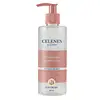What's inside
What's inside
 Key Ingredients
Key Ingredients

 Benefits
Benefits

 Concerns
Concerns

 Ingredients Side-by-side
Ingredients Side-by-side

Water
Skin ConditioningSodium Lauroyl Methyl Isethionate
CleansingSodium Cocoamphoacetate
CleansingGlycerin
HumectantCoco-Glucoside
CleansingGlyceryl Oleate
EmollientSteareth-10
EmulsifyingPropanediol
SolventPhenethyl Alcohol
MaskingUndecyl Alcohol
AntiseborrhoeicTocopherol
AntioxidantAnhydroxylitol
HumectantXylitol
HumectantHexylene Glycol
EmulsifyingCapryloyl Glycine
CleansingXylitylglucoside
HumectantMagnesium Aspartate
Skin ConditioningZinc Gluconate
Skin ConditioningRubus Chamaemorus Fruit Extract
AntioxidantCucumis Sativus Seed
ExfoliatingCitrus Limon Peel
MaskingChamomilla Recutita Flower
Skin ConditioningCamellia Sinensis Leaf
PerfumingDisodium EDTA
Water, Sodium Lauroyl Methyl Isethionate, Sodium Cocoamphoacetate, Glycerin, Coco-Glucoside, Glyceryl Oleate, Steareth-10, Propanediol, Phenethyl Alcohol, Undecyl Alcohol, Tocopherol, Anhydroxylitol, Xylitol, Hexylene Glycol, Capryloyl Glycine, Xylitylglucoside, Magnesium Aspartate, Zinc Gluconate, Rubus Chamaemorus Fruit Extract, Cucumis Sativus Seed, Citrus Limon Peel, Chamomilla Recutita Flower, Camellia Sinensis Leaf, Disodium EDTA
Water
Skin ConditioningDibutyl Adipate
EmollientPhenoxyethyl Caprylate
Methylene Bis-Benzotriazolyl Tetramethylbutylphenol
UV FilterDiethylamino Hydroxybenzoyl Hexyl Benzoate
UV FilterPropanediol
SolventPotassium Cetyl Phosphate
EmulsifyingEthylhexyl Triazone
UV AbsorberPentylene Glycol
Skin ConditioningCoco-Caprylate
EmollientBis-Ethylhexyloxyphenol Methoxyphenyl Triazine
Skin ConditioningAcrylates/C12-22 Alkyl Methacrylate Copolymer
Silica
AbrasiveButyrospermum Parkii Butter
Skin ConditioningHydrogenated Dimer Dilinoleyl/Dimethylcarbonate Copolymer
Emulsion StabilisingAllantoin
Skin ConditioningSodium Hyaluronate
HumectantLaminaria Ochroleuca Extract
Skin ConditioningHydroxyacetophenone
AntioxidantTocopherol
AntioxidantCaprylic/Capric Triglyceride
MaskingHelianthus Annuus Seed Oil
EmollientAluminum Starch Octenylsuccinate
AbsorbentDecyl Glucoside
CleansingCetyl Alcohol
EmollientStearyl Alcohol
EmollientCarbomer
Emulsion StabilisingArginine
MaskingSodium Stearoyl Glutamate
CleansingCoco-Glucoside
CleansingSodium Carbonate
BufferingCitric Acid
BufferingDisodium Lauryl Sulfosuccinate
CleansingPropylene Glycol
HumectantXanthan Gum
EmulsifyingMyristyl Alcohol
EmollientArachidyl Alcohol
EmollientWater, Dibutyl Adipate, Phenoxyethyl Caprylate, Methylene Bis-Benzotriazolyl Tetramethylbutylphenol, Diethylamino Hydroxybenzoyl Hexyl Benzoate, Propanediol, Potassium Cetyl Phosphate, Ethylhexyl Triazone, Pentylene Glycol, Coco-Caprylate, Bis-Ethylhexyloxyphenol Methoxyphenyl Triazine, Acrylates/C12-22 Alkyl Methacrylate Copolymer, Silica, Butyrospermum Parkii Butter, Hydrogenated Dimer Dilinoleyl/Dimethylcarbonate Copolymer, Allantoin, Sodium Hyaluronate, Laminaria Ochroleuca Extract, Hydroxyacetophenone, Tocopherol, Caprylic/Capric Triglyceride, Helianthus Annuus Seed Oil, Aluminum Starch Octenylsuccinate, Decyl Glucoside, Cetyl Alcohol, Stearyl Alcohol, Carbomer, Arginine, Sodium Stearoyl Glutamate, Coco-Glucoside, Sodium Carbonate, Citric Acid, Disodium Lauryl Sulfosuccinate, Propylene Glycol, Xanthan Gum, Myristyl Alcohol, Arachidyl Alcohol
 Reviews
Reviews

Ingredients Explained
These ingredients are found in both products.
Ingredients higher up in an ingredient list are typically present in a larger amount.
Coco-Glucoside is a surfactant, or a cleansing ingredient. It is made from glucose and coconut oil.
Surfactants help gather dirt, oil, and other pollutants from your skin to be rinsed away.
This ingredient is considered gentle and non-comedogenic. However, it may still be irritating for some.
Learn more about Coco-GlucosidePropanediol is an all-star ingredient. It softens, hydrates, and smooths the skin.
It’s often used to:
Propanediol is not likely to cause sensitivity and considered safe to use. It is derived from corn or petroleum with a clear color and no scent.
Learn more about PropanediolTocopherol (also known as Vitamin E) is a common antioxidant used to help protect the skin from free-radicals and strengthen the skin barrier. It's also fat soluble - this means our skin is great at absorbing it.
Vitamin E also helps keep your natural skin lipids healthy. Your lipid skin barrier naturally consists of lipids, ceramides, and fatty acids. Vitamin E offers extra protection for your skin’s lipid barrier, keeping your skin healthy and nourished.
Another benefit is a bit of UV protection. Vitamin E helps reduce the damage caused by UVB rays. (It should not replace your sunscreen). Combining it with Vitamin C can decrease sunburned cells and hyperpigmentation after UV exposure.
You might have noticed Vitamin E + C often paired together. This is because it is great at stabilizing Vitamin C. Using the two together helps increase the effectiveness of both ingredients.
There are often claims that Vitamin E can reduce/prevent scarring, but these claims haven't been confirmed by scientific research.
Learn more about TocopherolWater. It's the most common cosmetic ingredient of all. You'll usually see it at the top of ingredient lists, meaning that it makes up the largest part of the product.
So why is it so popular? Water most often acts as a solvent - this means that it helps dissolve other ingredients into the formulation.
You'll also recognize water as that liquid we all need to stay alive. If you see this, drink a glass of water. Stay hydrated!
Learn more about Water